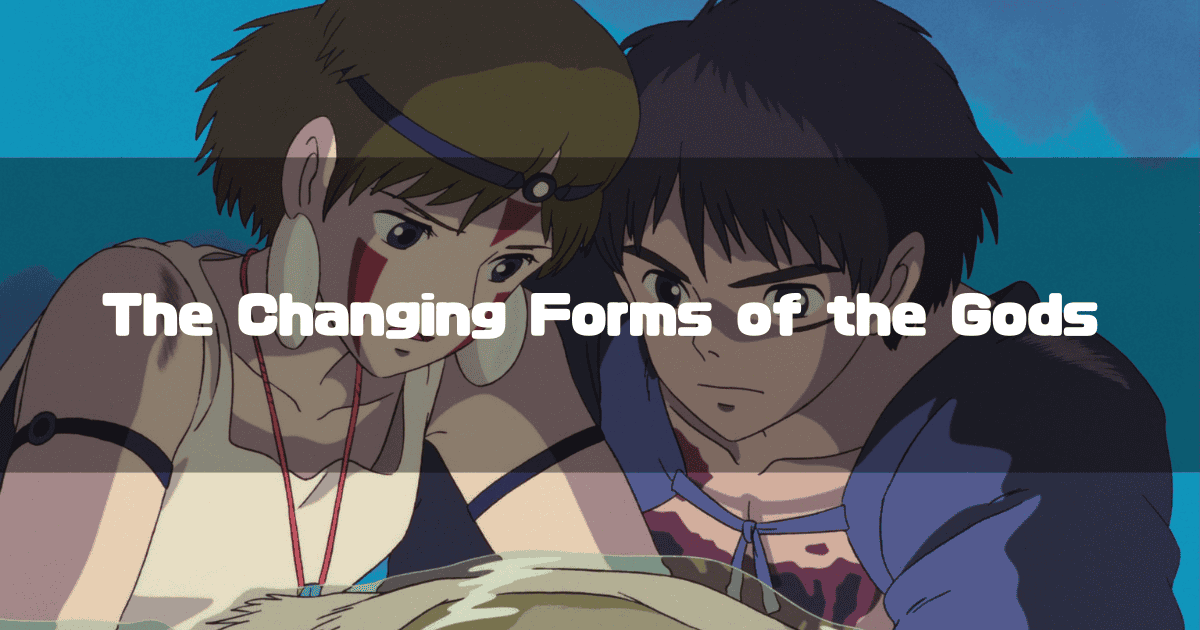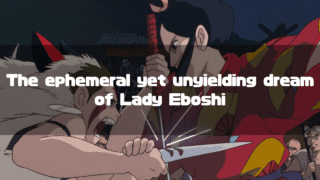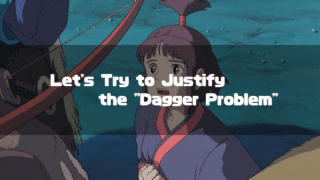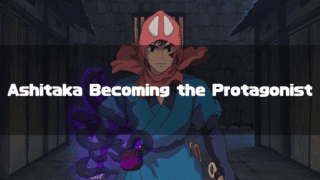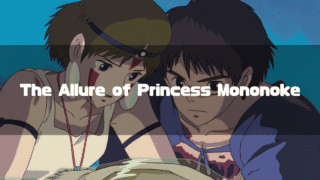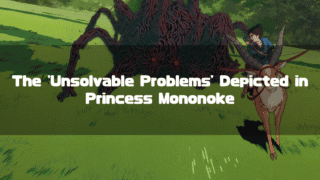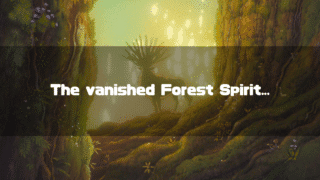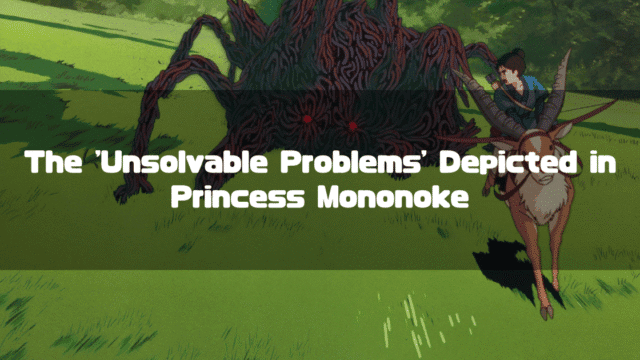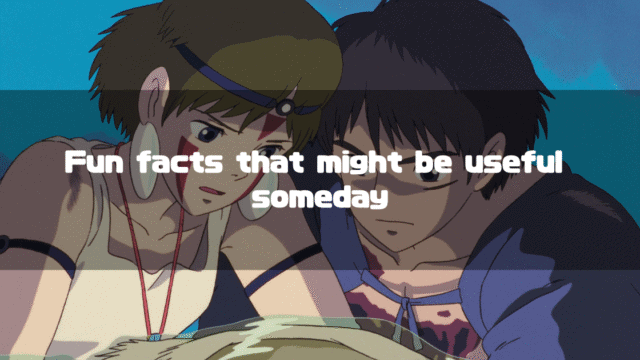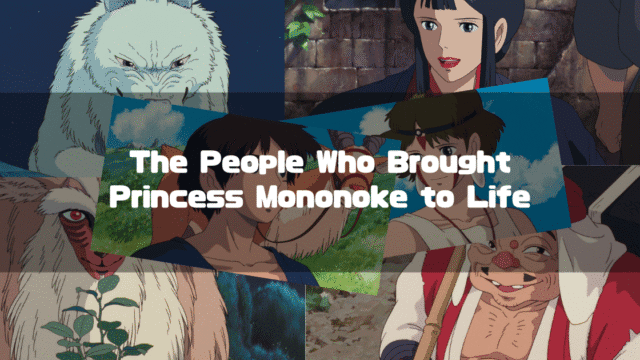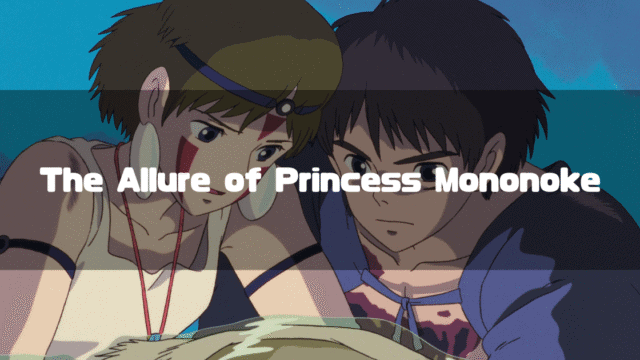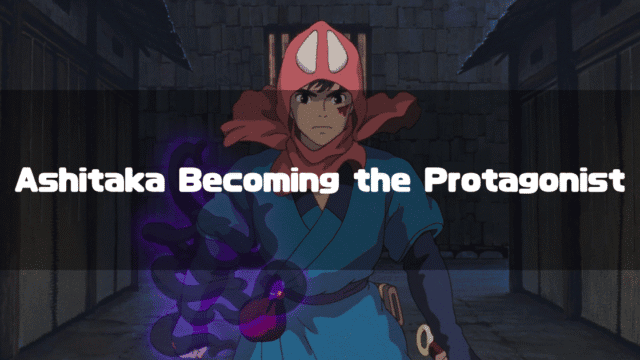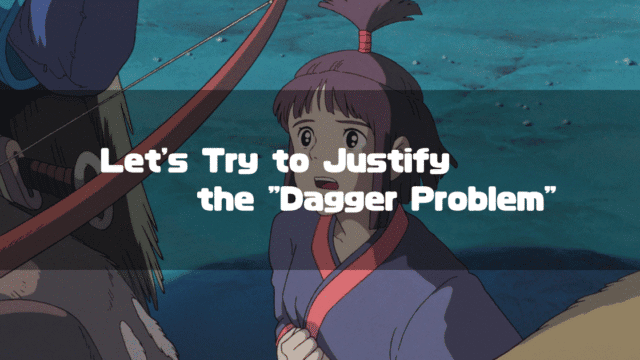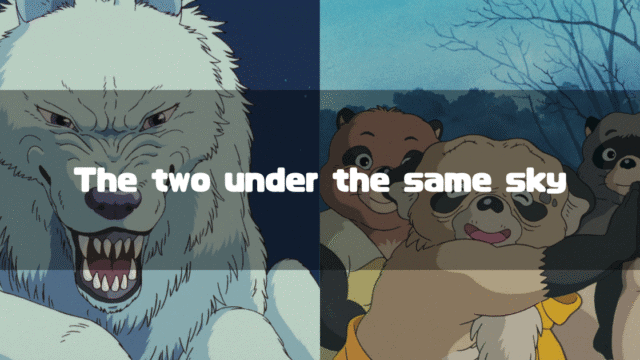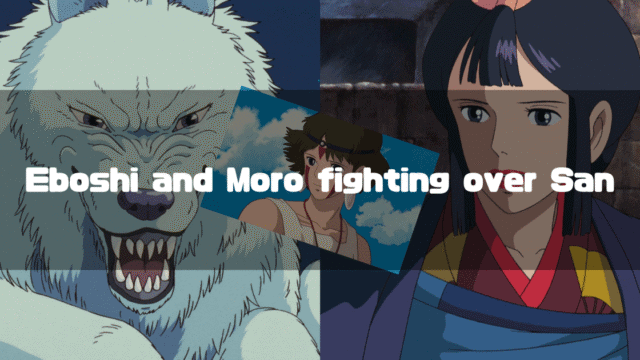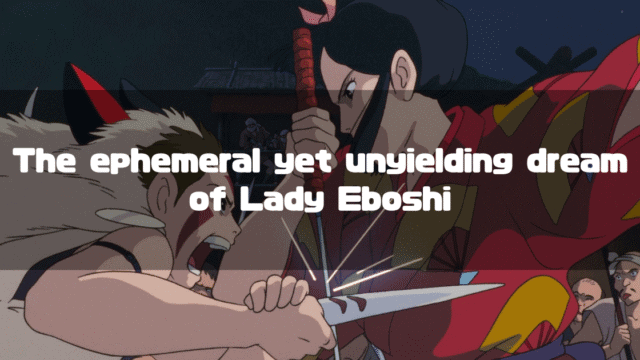Princess Mononoke(Studio Ghibli Official) is an animated film directed by Hayao Miyazaki, released in 1997. I have previously written about Princess Mononoke, considering why the end credits are completely black.
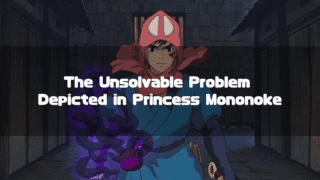
While the article above also touches on the content of the work, this time I want to think about “what ‘Princess Mononoke‘ was ultimately about” from the perspective of “deicide.” To do that, let’s first review the physical characteristics of the Forest Spirit.
*This article is an English translation of the original Japanese article, 「もののけ姫」は結局どういう話だったのか-神殺しってなに?-.
Let an AI walk you through the highlights of this post in a simple, conversational style.
- The Changing Form of the God
The form of the Forest Spirit drawn by Hayao Miyazaki is not humanoid but a mysterious being that encompasses animals, plants, and humans, symbolizing both “a sacred place where humans must not tread” and “the fear of the night.” The film captures the decisive moment when this “form of the god” changes at the popular level. - Deicide and the Shift in Values
By beheading the Forest Spirit, both sanctity and fear are lost, triggering a shift to an era where humans see nature as something “to be managed.” This is not just environmental destruction, but a major transformation of spiritual and religious values. - The Meaning of Returning It by Human Hands
The miracle that occurs when Ashitaka returns the head (the healing of the lepers) is a sign of the slight hope brought about by the awareness that “we must not forget what we have done.” Director Miyazaki’s message lies not in “absolute righteousness” but in “conscious humility.” - An Ending that Connects to the Present Day
The final scene, while overlapping with us in the modern era who consume nature, is depicted through Ashitaka, who continues to maintain his connection with San (nature), as an encouragement from director Miyazaki to “live sincerely, even while embracing contradictions.”
The Impressive Form of the Forest Spirit
Now, everyone. If someone asked you to “draw a picture of a god,” what kind of picture would you draw? Since “god” is a bit abstract, it’s fine to draw a “mountain god” or a “god who lives in the mountains.” In most cases, it would probably take a “human” form like the one below, wouldn’t it?

Of course, since we have already seen Princess Mononoke, we might intentionally try to draw a non-humanoid god, but I think if we don’t think about it, we tend to end up with something like the above. On the other hand, the form of the Forest Spirit created by director Miyazaki is as follows, a kind of being that our poor imagination could never create.
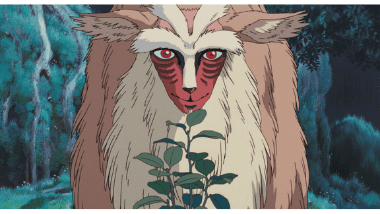
This Forest Spirit is not only non-humanoid but also contains various traits. In “The Ghibli Textbook 10: Princess Mononoke (ジブリの教科書10:もののけ姫, in Japanese),” director Miyazaki states the following:
“The Forest Spirit, which is the cornerstone of the story, is a completely imaginary animal with a human face, a beast’s body, and tree-like antlers.”
(Original Text in Japanese)
「物語のかなめのとなるシシ神とは、人面と獣の身体、樹木の角をもつまったく空想上の動物である。」
In other words, it has a form that symbolizes “the forest itself.” To consider “deicide” in Princess Mononoke, I believe that this impressive form of the “Forest Spirit,” which we mere mortals could never design, is extremely important.
What Was Princess Mononoke Really About? -The Meaning of Deicide-
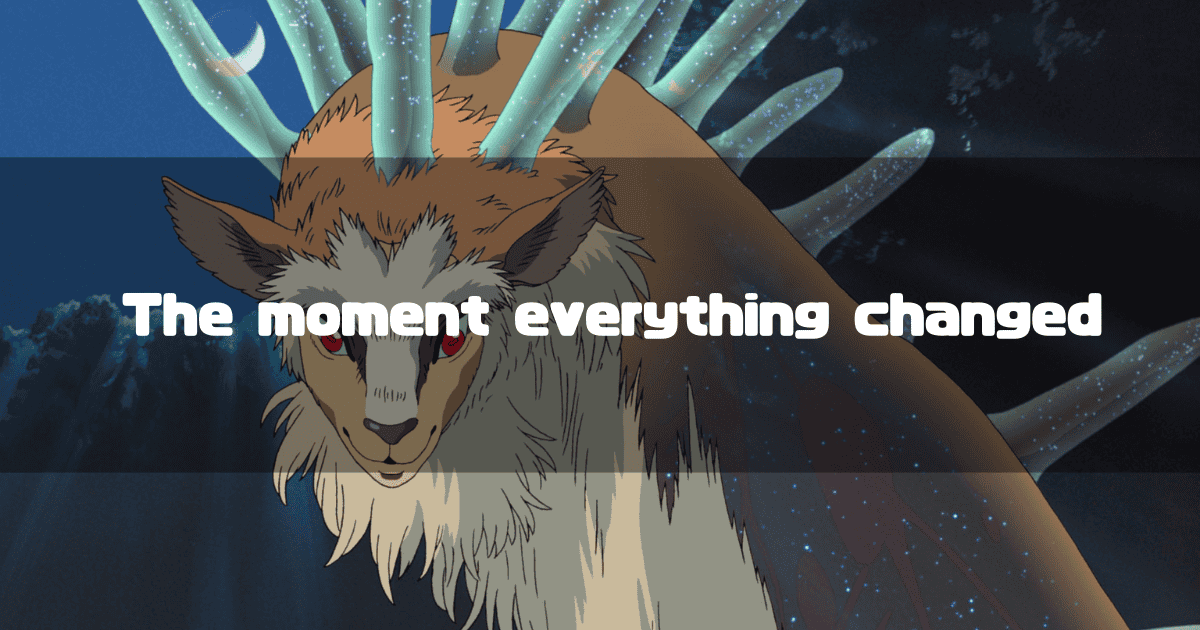
The Form of God Changes.
I briefly reviewed the form of the “Forest Spirit,” but now I would like to state the conclusion regarding the main theme of this article: “What was ‘Princess Mononoke‘ really about?” In the context of this article, Princess Mononoke is
a work that depicts the moment the “form of god” changed to a human form at the popular level.
That would be the conclusion. Historically, the “moment gods became humanoid” would be when the Kojiki and Nihon Shoki were compiled, which is much earlier than the Muromachi period, the setting of Princess Mononoke.
However, what Princess Mononoke depicts is not such a historical aspect, but rather a folkloristic one, capturing the moment when the way of thinking at the popular level changed.
In fact, the Muromachi period is considered an era when culture that continues to the present day blossomed. The transition of the image of gods among the common people (that is, us) was probably a gradual one, and I think it changed without anyone noticing. However, the dramatic and interesting part of Princess Mononoke is that it captures that “moment.”
What it Means to Kill a God.
In the context of this text, the conclusion is that it depicts “the moment the form of god changes,” but I want to think a little more about what it means for “the form of god to change.” I will again quote from an interview with director Miyazaki published in “The Ghibli Textbook 10: Princess Mononoke (ジブリの教科書10:もののけ姫, in Japanese)”:
“There is a feeling that still remains strong as a religious sentiment among many Japanese people. It is the belief that deep within our country, there is a very sacred place where people should not set foot, from which abundant water flows and protects the deep forest. I strongly hold the religious sense that it is most wonderful for humans to return to such a place of sanctity.”
(Original Text, in Japanese)
「今も多くの日本人の中に宗教心として強く残っている感情があります。それは自分たちの国の一番奥に、人が足を踏み入れてはいけない非常に清浄なところがあって、そこには豊かな水が流れ出て、深い森を守っているのだと信じている心です。そういう一種の清浄感があるところに人間は戻っていくのが一番素晴らしいんだという宗教感覚を、僕は激しく持っています。」
If the “Forest Spirit” is a symbol of “the forest itself,” then it must also be a symbol of “a very sacred place where people must not tread.” And what we must not forget is the existence of the Night-Walker (Didarabotchi).
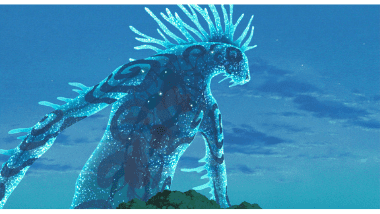
According to the making-of documentary for Princess Mononoke, How Princess Mononoke Was Born(「もののけ姫」はこうして生まれた、in Japanese), the Night-Walker is a symbol of “the darkness of night itself.” I think many people have had the experience of feeling a certain fear of the dark sky when they were small. In other words, the Night-Walker is also a symbol of the “fear” within us.
Recalling the “deicide” scene by Lady Eboshi, she could not kill the Forest Spirit when it was in its “Forest Spirit state.” It would probably be impossible to shoot and kill the Forest Spirit when it is completely in its “Night-Walker state” either. Lady Eboshi struck down the Forest Spirit in a state exactly between the “Forest Spirit state” and the “Night-Walker state,” that is, she struck down both the “sacred place” and “fear” at the same time.
Thus, to commit “deicide” is to destroy both the “very sacred place” and “fear” simultaneously, and as a result, for the “form of god” to become humanoid means bringing all of creation under human control.
So, in a “world where humans have become gods,” how does director Miyazaki think people should live? I don’t think he simply wanted to shout things like “Let’s bring back fear!” or “Let’s cherish the green!” It’s not that simple.
Of course, in the interview quoted above, he does say “it is most wonderful to return,” but looking at what is depicted in the film, it seems different. One specific reason I think so is Ashitaka’s line, “I want to return it with human hands.”
Why Return It with Human Hands?
In the climax of Princess Mononoke, the Forest Spirit’s head is shot off by Lady Eboshi. Jigo and his men try to take the head back, but they can no longer escape from the Night-Walker-fied Forest Spirit that is pursuing its head. Jigo still tries to defend the head to the death, but he is persuaded by Ashitaka and San to return it. The words Ashitaka says then are, “I want to return it with human hands.”
The meaning of the scene where Ashitaka says, “I want to return it with human hands,” is
“At the very least, let’s not forget that this is something we have done!“
isn’t it?
An important presence in the work Princess Mononoke is Irontown (Tatara-ba). As its name suggests, Irontown produces iron using tatara steelmaking, and for that, they cut down an extraordinary amount of trees. Is this depicted critically? No, it is also depicted as an “unavoidable” part of being human.
We live on, making various mistakes while thinking we are doing good. However, we must not forget the mistakes we have made, and perhaps all we can do is “live humbly, at the very least,” with that thought in our hearts.
At the end of the story, the Forest Spirit gets its head back, but it is too late, and it collapses onto the land. The forest, engulfed in the Forest Spirit’s explosion, undergoes a slight regeneration. Of course, it will never return to its original state and is destined to become a so-called “satoyama” (a village-mountain landscape).
However, a tremendous miracle occurs in this final scene. The wounds of the people wrapped in bandages are healed. This is arguably the only positive scene in the entire work of Princess Mononoke.
Why did such a miracle happen at the very end? It was probably because Ashitaka and San returned it with human hands.
I believe the people in bandages were a symbol of those with Hansen’s disease (leprosy). They were unjustly isolated and had their lives taken from them. And this did not just happen by chance; it was entirely “something we did.” In other words, the scene where the bandaged people are healed was perhaps director Miyazaki’s almost sole positive message: “If we can at least be self-aware, a slightly better future might come.”
Why Ride Yakul to Go?
Finally, I want to think about the last scene with Ashitaka and San. When Princess Mononoke was released, I was in the 6th grade of elementary school, and to my child’s heart, that ending was incredibly poignant.
Thinking about it again as an adult, I believe that scene represents “having committed deicide, they have embarked on a path that continues to the modern day.”
We who live in the modern era, “ride” the Shinkansen to see a river, “ride” an airplane to see a forest, and “ride” a ship to consume Yakushima. The modern era is an age where we “go” to consume nature. There is no continuous life connected to it, nor is there fear. Ashitaka has boarded that very path leading to our modern times. That is why Ashitaka, like us today, will live in Irontown and “ride Yakul to go” see San (the forest).
However, Ashitaka does not take the position of simply consuming nature like we do. Because San is there. From now on, Ashitaka will be caught between Irontown and San, and will live days of anguish. Director Miyazaki himself talks about this, seemingly with some enjoyment, in front of Joe Hisaishi in How Princess Mononoke Was Born(「もののけ姫」はこうして生まれた, in Japanese). After thinking about it, that last scene is
“Children! Things won’t be easy, but like Ashitaka, live with all your might even while suffering!“
It can also be taken as an encouragement from director Miyazaki to the children of that time (that is, people of my generation).
Summary
To summarize the above:
The film Princess Mononoke is a work that dramatically depicts the moment the “form of god” within the common people (us) changed to a human one. It portrays the cause of this “change in the form of god” as “deicide,” which means that we Japanese ourselves destroyed our “‘fear'” of the “‘sacred’.”
The reason Ashitaka and San tried to return the Forest Spirit’s head “at least by human hands” is a manifestation of the message that we should be “at least self-aware” that such “destruction of fear” did not occur naturally, but was something we ourselves had done.
The fact that San and Ashitaka cannot live together at the end is the very state of us in the modern era, and it is the beginning scene of Ashitaka’s “beautiful suffering” as he steps into the modern age.
I believe this is the case.
Princess Mononoke seems to have many more aspects than what I have written here, so there will be people who take an opposing view to my opinion or are disgusted by the shallowness of my thoughts, but if I say what I’ve written in this article, I might be able to “fool the young ones.”
Appendix: Why Did Nago Come to the East?
The driving force of the work Princess Mononoke and the being that cursed Ashitaka is Nago. The Tatarigami (curse god) is a symbol of something “unavoidable,” so it is meaningless to think about why Nago attacked Ashitaka’s village.
However, we might be able to think to some extent about why he fled to the “East.”
Speaking of “heading east,” one thinks of “Emperor Jimmu’s eastern expedition” and the “subjugation of the Emishi.” What we learn as “Japanese history” is the “success story of the Yamato regime,” which began in Kyushu and is a tale of its power expanding ever eastward. The work Princess Mononoke may have ironically depicted this “eastward” success story of the Yamato regime as a “process of losing ‘fear’.”
In other words, Nago was afflicted by the poison of the stone bowguns of people who had lost their “fear,” so he sought a way out in the “East,” which still retained that “fear.” And to the descendants of the Emishi, who had not lost their “fear,” Nago “correctly” appeared as a Tatarigami.
Ashitaka’s figure, shouting “Calm yourself! Calm yourself!”, was precisely that of a “descendant of the Emishi who knows ‘fear’,” but the moment he decided to “fire an arrow in return,” Ashitaka also resolved to walk the same path as us modern people.
Whether you call it sad, poignant, or unavoidable. I think Princess Mononoke is truly a work that cannot be easily understood.
The images used in this article are from Studio Ghibli Works Still Images.
About the Author
Recent Posts
- 2025-10-21
Indiana Jones and the Dial of Destiny(2023): Full Synopsis & Analysis: Indy’s True Motive and the Enigma of Helena - 2025-10-15
Indiana Jones and the Dial of Destiny(2023):Historical Background-WWII, the Real Dr. Schmidt, the Siege of Syracuse, and the Antikythera Mechanism - 2025-10-08
Why Does Children Who Chase Lost Voices Feel So Ghibli-esque? [Makoto Shinkai’s “Tale of Farewell”] - 2025-10-07
5 Centimeters per Second: Characters, Voice Actors, Character Analysis and Character Map - 2025-10-06
5 Centimeters per Second: Full Synopsis, Analysis, Ending Explained & Character Map (Spoilers)

